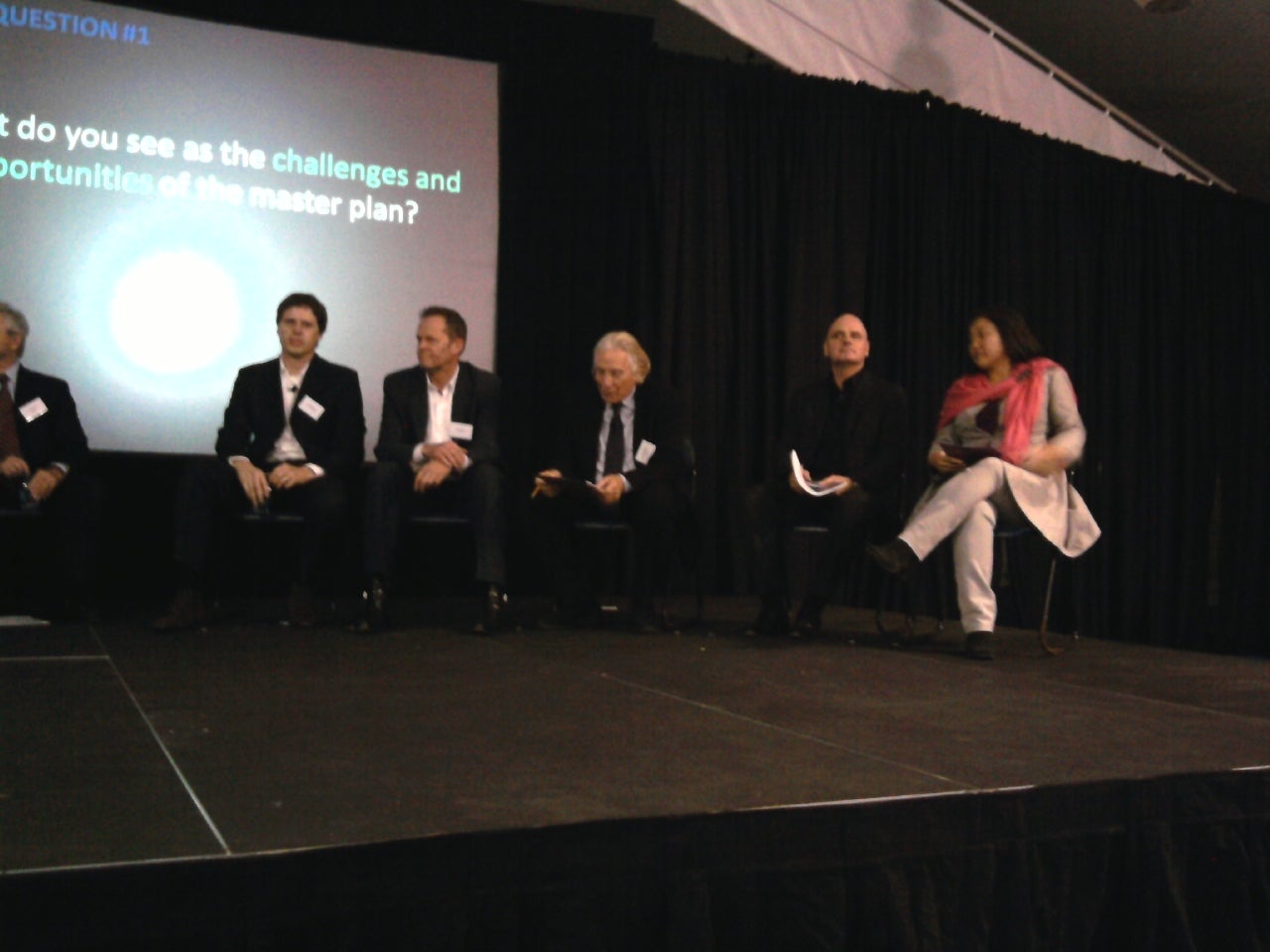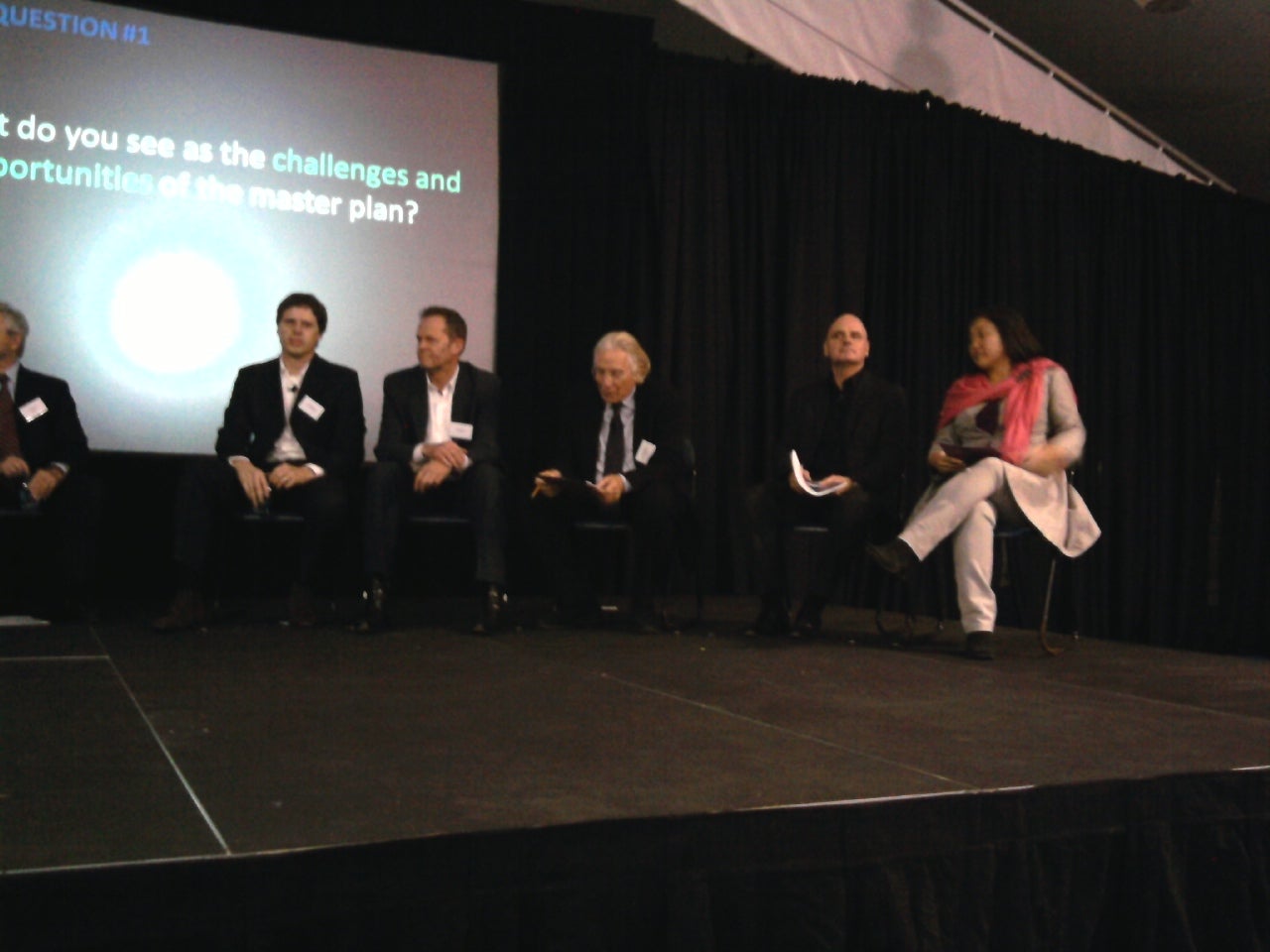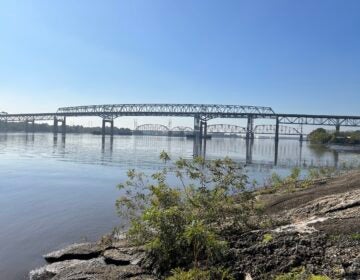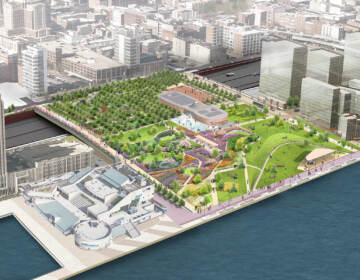Delaware River Waterfront Corporation master plan moment
Nov. 10
By Kellie Patrick Gates
For PlanPhilly
The teams competing to create the Central Delaware Waterfront Master Plan hold the same position on at least two things: Creating and implementing the blueprint won’t be easy. And it will not be fast.
About 200 people attended a meet-and-greet with representatives of the five finalist teams at Festival Pier on Tuesday night. They are: Beyer Blinder Belle / Weiss Manfredi; Civitas / West 8; Cooper Robertson & Partners; James Corner Field Operations; and WRT

The challenges listed by team representatives include: The struggling economy. The lingering perception among Philadelphians – who have seen riverfront plans come and go without changing much – that nothing will ever happen. The fact that upwards of 95 percent of the riverfront land between Oregon Ave. and Allegheny Ave. is in private hands. The sheer size of the project – it will take decades for the plan to be fully realized. And while one of the biggest goals of the master plan is to reconnect Philadelphia to its waterfront, a thick ribbon of highway – I-95 – is a huge physical barrier.
(Many Philadelphians who have taken part in re-imagining the Central Delaware have dreamt about somehow getting rid of the I-95 barrier. Burying it is a common idea. Inquirer Architecture Critic Inga Saffron caused a stir with a column that suggested simply removing part of the highway and re-routing traffic onto Delaware Avenue. But Tuesday night, Alan Greenberger, deputy mayor for planning and commerce and executive director of the planning commission, said the highway is with us, in virtually its present state, for at least the next 20 years, as PennDOT is rebuilding it. Greenberger said his staff is investigating ways to make connections with the river “under, over and through I-95,” but they are not pondering what could be done if the roadway were not where it is. That, he said, would be a waste of their time.)
As hard as they think the assignment will be, all five teams seemed eager to dig in.
“We really see that the opportunities outweigh the challenges,” said Todd Hoehn, project manager at Weiss Manfredi.
“It’s nothing short of redefining the city,” said James Corner, principal in charge of James Corner Field Operations.
Each team answered questions from Marilyn Jordan Taylor – Dean of the Penn School of Design and chair of the Delaware River Waterfront Corp. committee that will recommend the winner to the full DRWC board – about the challenges and opportunities of the waterfront plan, and where best to start working. (See video)
The team reps had only two minutes to answer each question. More detail was available by looking at their handouts and presentation boards they had set up in another part of the room, science fair style.
Here is a bit of what each team is thinking at this point. Note that no team has anything even close to a full plan yet. Taylor’s committee is meeting Wednesday to discuss the input received Tuesday night and in order to get a sense of what everyone is thinking, DRWC President Tom Corcoran said. The committee will then have more questions for the candidates. Taylor said she hopes to bring the final recommendation to the full DRWC board on Nov. 23. Contract negotiations would take place in December, and the winner would begin work in January. The master plan won’t be finished for another 12 to 18 months.
Beyer Blinder Belle and Weiss/Manfredi: Hoehn said the total space in the Master Plan area is about 1,200 acres. “The chances of developing the whole thing – it would take more than 100 years,” he said. So the team proposes focusing on about 100 key acres instead. The plan was inspired by William Penn’s squares, from which the city grew, he said. The 100 acres that would be developed in this team’s vision would be like a charm bracelet. The “charms” could inspire future growth between them. The team brochure lists five areas for the charms: The Lehigh Viaduct, Penn Treaty Park, Festival Pier, Penn’s Landing and Big Box Land – the area of Walmart, etc. in South Philly.
Civitas of Denver and New York/ West 8: Principal-in-charge Mark Johnson said his team would like to start with some temporary parks. “They could pop-up right on the water next summer,” he said. A May Day festival, for example, would bring people there immediately. “We have to do something bold and visionary – and make people believe that this is real,” he said. The Civitas team also refers to prospective hot spots along the Delaware as a charm bracelet. The team’s brochure says that “micro investments place by place are achievable and add up to continuing successes.” It imagines a light-rail system as a gateway to the waterfront, and says effort must be made to “ensure that casinos create a welcoming public waterfront.”
Cooper Robertson & Partners: Alexander Cooper, partner-in-charge, said that the early projects should be based on what Philadelphians want most. “Turn that question to this audience,” he said. “Finding out what people want to do is the way to get the public to the waterfront.” The team’s literature says it is important to develop a comprehensive plan for the parks along the water and to capitalize on the success of city neighborhoods. It also says that the comprehensive plan for this stretch must include a plan for the water, not just the land.
James Corner Field Operations: Corner said it was important to identify projects that could be completed quickly to offset negative public perception about the possibilities. And it was also important to fix the transportation situation now, because if people can’t get there, there’s no point. He suggested that connecting the surface streets to the river – even just through signage – would create “buzz,” as would holding public events on the waterfront. He also suggested a passport program for children, where they would receive stamps for visiting waterfront destinations. Corner Field’s brochure says that waterfront development should reflect the rest of the neighborhood where it occurs as a way of extending neighborhood feel to the river.
WRT of Philadelphia: Principal-in-charge Mami Hara said there is enough space on the waterfront for “diversity in use.” WRT imagines re-use of Pier 9 as an entertainment destination. Each waterfront neighborhood could have an activity barge that reflects the special flavor of the neighborhood, she said. WRT’s brochure stresses the importance of creating a waterfront that is authentic Philadelphia.
Jay Donner and Wendell Jones, who live at Front and Queen Sts., said they came to the event because the river front is so close to their neighborhood. “I’ve always felt the utilization of our waterfront is nothing compared to other cities,” Donner said. “But there is great opportunity.” Donner has been thinking about public transportation. It is vital to a vibrant waterfront, he thinks. But unlike Corner, he hopes other improvements are completed and successful before money is spent on increasing public transportation, as he sees little sense in paying for transit until people have a reason to use it.
Jones said he hopes that the Master Plan will keep the Grand Plaza at Penn’s Landing. “I’ve always been happy with the Grand Plaza,” he said. “I think it is one of the most successful parts.” He also hopes the sky tram to Camden is either completed, or the base that was built for it is removed.
Craig Schelter, executive director of the non-profit Development Workshop, said he hopes the final version of the Master Plan is realistic enough in scope to become reality. “Vision without implementation is illusion,” he said.
Schelter and the Development Workshop have been paying close attention to the long-range planning for the Central Delaware. The Master Plan will inspire the passing of zoning and ordinances to codify the goals it contains. In the meantime, City Council created a zoning overlay with the intent to protect property so that future goals can be reached. That overlay calls for a 100-foot setback in most cases, an amount Schelter has said would often be too much for a parcel. He has also said that private landowners should in some way be compensated for the loss of this land.
In coming months, the Planning Commission will be adopting more detailed guidelines for the implementation of the overlay.
After the finalists’ question session, Taylor, Corcoran, and Greenberger took questions from the audience. Concerns included how the river re-development would be financed, and the impact of the proposed casinos.
“Money comes to good projects,” Corcoran said. He said that when the city first started talking about creating bike trails and turning derelict piers into parks, there was no money. But these projects are now funded “even in these times. And these times will change,” he said. A good plan is the best way to attract funding, from government and other sources, he said.
Some who oppose casinos were present at the meeting, although they were much quieter than usual. Mayor Michael Nutter spoke early in the program, and Northern Liberties resident Hilary Regan held up a photo of a crammed parking lot – a criticism of the city allowing SugarHouse Casino to proceed with an interim plan that includes a great deal of surface parking.
Greenberger said the casino or casinos – Foxwoods is also currently planned for the waterfront, although no one at the city has heard much about their plans – will not have that big of an impact. “We will be a city with a casino or casinos, but we will not be a casino city,” he said.
Society Hill Civic Association president Rosanne Loesch remained concerned after the meeting. “It’s really exciting that a Master Plan could finally come to fruition here,” she said. “But I am brought down to earth when I hear the word ‘casino’,” she said. “SugarHouse is a big box in a sea of surface parking. How does that fit into the Vision?” The Vision for the Central Delaware is a document put together by PennPraxis after more than one year of public input. It is a foundation document for the Master Plan.
The city agrees with the Master Plan finalists that public perception – good or bad – is powerful. The desire to show Philadelphians that projects can be accomplished is part of the reason why DRWC and the Center City District have already built part of a waterfront trail and embarked on a re-do of Pier 11 – concept designs for that will be unveiled at a public meeting at the Festival Pier tent next Wednesday.
Even words can make a difference, Greenberger said. He announced that from now on, the City will call Pier 11 the Race Street Pier, newly connecting the street to the pier at its foot and the river beyond.
Contact the reporter at kelliespatrick@gmail.com
WHYY is your source for fact-based, in-depth journalism and information. As a nonprofit organization, we rely on financial support from readers like you. Please give today.







